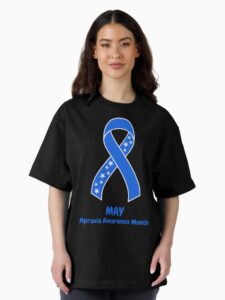Apraxia Awareness Month: Understanding and Supporting Individuals with Speech Apraxia
May marks a significant time in the calendar for raising awareness about a lesser-known condition that impacts the lives of many individuals and families worldwide – Apraxia Awareness Month. This dedicated month aims to shine a light on apraxia, a condition that affects speech and motor coordination, and to foster understanding and support within communities.

Apraxia Awareness |
What exactly is apraxia?
Apraxia, specifically speech apraxia or childhood apraxia of speech (CAS), is a neurological disorder that affects the ability to plan and execute the movements necessary for speech production. Unlike other speech disorders that affect the muscles used in speaking, such as dysarthria, apraxia is a result of the brain’s difficulty in coordinating the muscle movements required for speech. This can make it challenging for individuals with apraxia to accurately produce sounds, syllables, and words, impacting their ability to communicate effectively.
What is the Color for Apraxia Awareness Month
In recognition of Apraxia Awareness Month, the color blue is embraced as a symbol of hope and support for individuals and families affected by apraxia. Blue serves as a reminder of the importance of empathy and understanding in the face of challenges posed by this condition. Through awareness initiatives and wearing blue, communities unite to show solidarity and to amplify the voices of those living with apraxia.
|
|
| Apraxia Awareness Month |
Apraxia symptoms
Recognizing the symptoms of apraxia is crucial for early intervention and support. Some common symptoms of speech apraxia include:
Inconsistent Speech: Individuals with apraxia may demonstrate inconsistent ability to produce sounds, syllables, or words, with variations in clarity and accuracy.
Difficulty with Sequencing: They may struggle with sequencing sounds or syllables in the correct order, leading to choppy or disjointed speech.
Limited Repertoire of Sounds: People with apraxia may have a limited range of sounds or syllables they can produce, affecting their ability to communicate effectively.
Groping Movements: In severe cases, individuals may exhibit groping movements of the lips, tongue, or jaw as they attempt to produce speech sounds.
Early diagnosis and intervention are crucial for individuals with apraxia to receive the support they need to develop effective communication skills. Apraxia testing typically involves a comprehensive assessment by speech-language pathologists (SLPs) who specialize in diagnosing and treating speech disorders. These assessments may include:
Oral Motor Examination: SLPs observe the movements of the lips, tongue, and jaw during speech production to assess motor coordination and control.
Articulation Tests: These tests evaluate the individual’s ability to produce specific sounds, syllables, and words, noting any inconsistencies or errors in speech production.
Language Assessment: SLPs assess the individual’s overall language abilities, including comprehension, expression, and vocabulary usage, to determine the impact of apraxia on communication skills.
Motor Speech Evaluation: This evaluation focuses on the coordination and timing of movements involved in speech production, providing insights into the underlying causes of apraxia.
Advocating for Awareness and Support
Apraxia Awareness Month serves as a reminder of the importance of advocacy, education, and support for individuals with apraxia and their families. By fostering understanding and acceptance, we can create inclusive communities where everyone has the opportunity to communicate and connect with others effectively.
As we wear blue and raise awareness throughout May, let us stand in solidarity with those affected by apraxia, offering compassion, support, and encouragement on their journey towards communication success. Together, we can make a meaningful difference in the lives of individuals with apraxia, helping them to find their voice and share their stories with the world.
Moreover, Apraxia Awareness Month provides a platform for amplifying the voices of individuals living with apraxia and their families, shedding light on the daily challenges they face and the importance of access to appropriate resources and support networks. It is a time to celebrate the resilience and determination of those navigating the complexities of apraxia, inspiring others with their perseverance and courage.
One of the key aspects of Apraxia Awareness Month is education. By increasing understanding of apraxia within our communities, we can combat misconceptions and stigma surrounding the condition. Many people may not be familiar with apraxia or may hold inaccurate beliefs about its causes and implications. Through educational initiatives, workshops, and informational resources, Apraxia Awareness Month empowers individuals to become advocates for themselves and their loved ones, promoting greater awareness and acceptance.
In addition to raising awareness, Apraxia Awareness Month serves as a call to action for improved access to diagnosis and treatment services for individuals with apraxia. Early intervention is crucial for maximizing communication outcomes and supporting overall development. However, many individuals may face barriers to accessing timely and appropriate services due to factors such as limited healthcare resources, financial constraints, or lack of specialized expertise in their area.
Conclusion
In conclusion, Apraxia Awareness Month is a time to come together as a global community to raise awareness, promote understanding, and advocate for individuals living with apraxia. By wearing blue, sharing information, and participating in educational and fundraising activities, we can make a meaningful difference in the lives of those affected by this condition. Together, let us strive to create a world where individuals with apraxia are fully supported, empowered, and included, enabling them to reach their full potential and thrive.
May Awareness Campaigns and Colors
Join us in May not only to shine a light on arthritis but also to explore the myriad of campaigns dedicated to raising awareness and making a difference. From Mental Health Awareness Month to Asian American and Pacific Islander Heritage Month, there’s a wealth of knowledge and advocacy waiting for you. Let’s stand together in solidarity, embracing the diversity of causes and amplifying our collective impact. Dive into the rich tapestry of campaigns this May and be inspired to make a difference!

